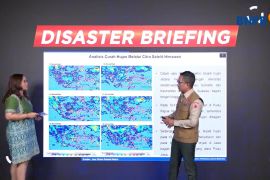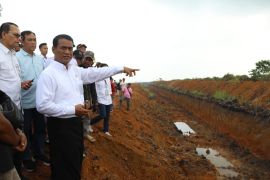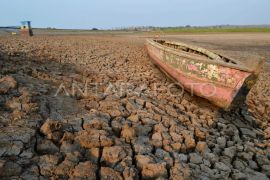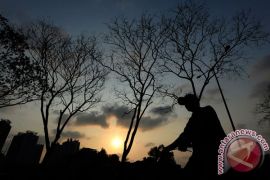We continue to monitor the signs of La Nina, and we do not exactly know how it would be."Jakarta (ANTARA News) - Indonesia was hit hard by the El Nino weather phenomenon last year and has been described by experts as one of the worst ever to be experienced in history.
El Nino triggered a prolonged drought, caused crop failures, and led to forest, peatland, and plantation fires, particularly on the islands of Sumatra and Kalimantan, in 2015.
The fires ravaged over 2.6 million hectares of forest and peatland areas and produced toxic haze.
The environmental disaster impacted the health, education and livelihoods of millions of people on the two major islands of Indonesia as well as neighboring countries particularly Singapore and Malaysia.
Early estimates of the total economic costs of the fires in 2015 in Indonesia alone exceed US$16 billion, according to the World Bank, which is helping to assess the costs of the fires and haze in a variety of sectors.
Approximately 5 million students were impacted by school closures in 2015, a feature story entitled "Indonesias Fires and Haze Crisis" posted on the World Bank website in November 2015 said.
"While not yet fully analyzed, the costs related to biodiversity may exceed US$295 million for 2015. The long-term impact on wildlife and biodiversity is also not fully known, but thousands of hectares of habitat for orangutans and other endangered species have been destroyed," the World Bank wrote.
As the country is still grappling with the impacts of El Nino, the national meteorological, climatology and geophysics agency (BMKG) has recently announced that another natural phenomenon called La Nina, which is the opposite of El Nino and usually triggers a heavy rainy season in Indonesia, is forecast to begin in September 2016.
"We continue to monitor the signs of La Nina, and we do not exactly know how it would be. El Nino is forecast to weaken after March, following which there will be a balance, and thereafter, La Nina will occur whose impacts would likely be felt in the end of 2016," Head of BMKGs Meteorology and Publication Department, Mulyono R. Prabowo, stated.
He could not forecast the intensity of La Nina, but it would usually be milder. He, however, cautioned inhabitants of the regions prone to landslides to be on alert.
La Nina would likely trigger floods in urban areas such as Jakarta, he pointed out.
"Southern Jakarta will experience high precipitation, and it will affect Central Jakarta," he noted.
Sea tides and the lack of water absorption areas could worsen the flooding.
"In such a situation, water pumps will not be effective," he remarked.
Both El Nino and La Nina have gravely impacted Indonesia in the past.
Prabowo has forecast high precipitation in February and March this year, and later it will slow down.
The meteorology agency and the Agriculture Ministry have developed a dynamic planting calendar to help farmers decide when to plant and which crops are suitable for planting in certain seasons.
In fact, the agriculture ministry is making preparations in anticipation of the natural phenomena La Nina, which usually leads to a very wet and prolonged rainy season in certain regions.
The anticipatory measures are crucial to mitigate the impact of La Nina on agricultural crop production, Agriculture Minister Amran Sulaiman said recently.
"The BMKG has forecast that the weather will remain normal this year. La Nina is likely to occur in October, but we are preparing in advance, as we did while dealing with drought last year," the minister stated.
To mitigate the impact of floods that could lead to crop failure, the ministry will improve irrigation networks, provide pumps to dispose of water, and build deep as well as shallow wells to absorb water in flood-prone areas, such as those in Karawang in West Java Province and Jombang in East Java.
He has also coordinated with the National Logistics Agency (Bulog) to shore up rice stocks before La Nina-induced downpours start affecting the farming activities.
Furthermore, the National Disaster Mitigation Agency (BNPB) has warned that La Nina might intensify hydrometeorological natural disasters, such as floods, landslides, and whirlwinds in parts of the country this year.
"Based on BMKGs forecast, La Nina phenomenon is likely to strengthen in mid-2016," BNPB spokesman Sutopo Purwo Nugroho remarked on Dec. 18, 2015.
He said at least 315 districts and municipalities are expected to experience flooding, affecting more than 63.7 million people. Some 274 districts and municipalities are at risk of landslides.
Due to high precipitation, the provinces of Central, West, and East Java are prone to flooding, landslides, and strong winds, he pointed out.
To anticipate landslides, the BNPB needs to install hundreds of early warning devices, but the agency currently only has 50 units.
Last year, the agency had informed that 99 percent of the natural disasters hitting Indonesia in 2014 were hydro-meteorological in nature -- floods, landslides, and whirlwinds.
The agencys data showed that 496 instances of whirlwinds, 458 floods, and 413 landslides affected Indonesia during 2014.
Landslides led to 338 deaths, displaced 79,341 residents, and damaged 5,814 houses in Indonesia in 2014.
(T.F001/INE/KR-BSR)
Reporter: Fardah
Editor: Priyambodo RH
Copyright © ANTARA 2016











